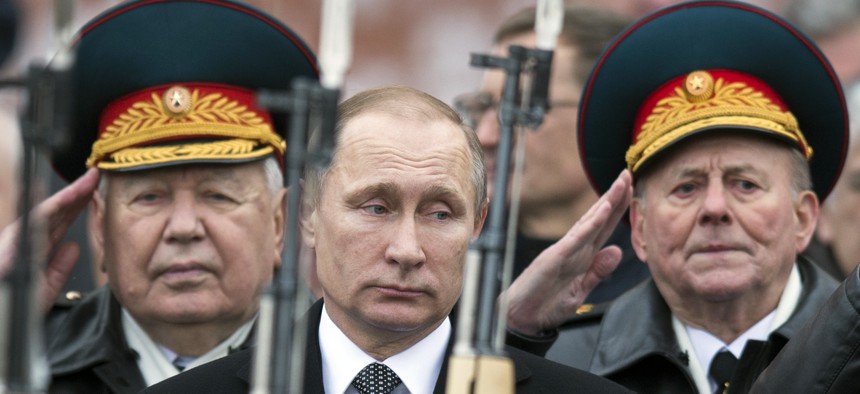
On Defenders of the Fatherland Day, Russian President Vladimir Putin attends a wreath-laying ceremony at the Tomb of the Unknown Soldier in Moscow, Feb. 23, 2016. AP Photo/Pavel Golovkin
Don't Fall for Obama's $3 Billion Arms Buildup at Russia's Door
There is no Russian resurgence. Washington is playing on your Cold War fears to get you to pay for something the U.S. does not need and can’t afford.
In one of the key justifications for the new $600 billion defense spending request, the Department of Defense has fallen back on a tried-and-true Cold War boogeyman: the threat of Russian aggression against allies in Europe. While there is no ignoring the Russian annexation of Crimea in 2014 and the Russo-Georgian war in 2008, to interpret these events as some kind of Russian “resurgence” is to grossly inflate the danger Russia poses to NATO and the United States.
Ukraine and Georgia were targeted precisely because they fell outside of U.S. security guarantees, lacked significant strategic importance to the west, and, most importantly from the Russian viewpoint, were making overt moves toward NATO membership. Russia has long opposed the expansion of NATO into its traditional sphere of influence. The reasons are rooted in a history of aggression from Western Europe, as memories of the devastation meted out by Napoleon, Kaiser Wilhelm, and Hitler still linger.
While Russia suffered little for its war against Georgia, the annexation of Crimea proved to be an incredibly damaging move. Though Crimea has been a historic lynchpin of Russian grand strategy for centuries, its open use of military force and political manipulation there in the midst of the Ukrainian Revolution drew an immediate response in the form of sanctions from the West. Russia is paying a massive economic and diplomatic cost for its aggression against Ukraine, from its ejection from the G8 to the cratering of its currency.
It is important to keep all this in mind when looking at the assumptions underlying the Pentagon’s budget request. President Barack Obama wants to quadruple the budget for the European Reassurance Initiative, or ERI, from $789 million to $3.4 billion. What’s the ERI? It’s a U.S. program started in 2014 in response to the Crimean annexation to bolster the ability of NATO to deal with destabilizing actions. In other words: Obama just asked Congress to fund the biggest military buildup by NATO in Eastern Europe since the Cold War.
But what will this program accomplish? It’s meant to deter further Russian aggression, but fails to identify where that aggression might reasonably fall. A NATO buildup of this magnitude also neglects to take into account just how provocative such a move would be; by concentrating troops on Russia’s border, we are playing into Putin’s long-standing criticisms of NATO encirclement.
Claims that any NATO member is at risk of Russian invasion is a flawed reading of recent history. No matter what one might think of Putin, the idea that he would risk a war with NATO is ridiculous on its face. That is a no-win scenario, and Putin’s past behavior all points to interventions where there is a very minimal risk of western involvement.
The Russian Federation of today is not the Soviet Union of the 1980s, despite the fervent wishes of those looking to restart the Cold War. Moscow’s military spending has increased in real terms and as a percentage of GDP in the last several years. Current estimates figure it between $70 billion and 85 billion (which matches about 15 percent of the U.S. defense budget). But Russia’s economy is in recession. The Russian military no longer has the ability to mobilize the combined forces of the USSR and Warsaw Pact as it once did. Nearly all of its former client states, with the exception of Ukraine, Belarus, and Moldova, are now NATO members. No amount of spending or technological development by Russia is going to change the fact NATO countries represent over 900 million people who spend nearly a trillion dollars per annum on defense.
The Defense Department is inflating the threat Russia poses, which allows the Obama administration, senior military leaders, and supporters in Congress to justifying maintaining the historic highs in defense spending, which in real terms in now more than the U.S. spent during the Cold War. Meanwhile, the U.S. debt continues to grow ever-staggering heights while critical investment opportunities are ignored. The U.S. budget, despite the $4 trillion price tag this year, is finite. Billions that go to support placing more equipment in Eastern Europe and putting an armored brigade on rotation are billions that cannot be spent retraining U.S. workers or rebuilding America’s failing infrastructure.
President Dwight D. Eisenhower, shortly after the death of Joseph Stalin in 1953, eloquently stated, “Every gun that is made, every warship launched, every rocket fired signifies, in the final sense, a theft from those who hunger and are not fed, those who are cold and are not clothed.” Voters and their representatives have a choice to make: continue down the road of reckless spending to counter phantom threats, or acknowledge that to truly secure the future of this country, we must tend to our own house and strengthen its foundations.



